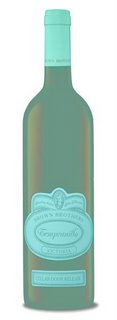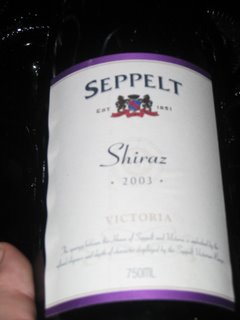
Brown Brothers Tempranillo 2003 (Victoria)
The better-half (oh, how I pine for the days when I could refer to her as the 'leader of the opposition' and get away with it - those days ended when one of you blabbed and told my darling wife about my blog) prepared a sensational roast chicken meal this evening. (I will get back to giving recipes and showing photos in the near future).
I thought this would be the perfect opportunity to road-test the Brown Brothers Tempranillo 2003. Again, this is a variety of which I know little and have tasted less than that. The bottle says to drink within 3-5 years of the vintage date and that it was good with roast chicken, so it got the call up. This was one of the wines from the Wine Society which I promised to review.
I found the Tempranillo to be surprising. My first impressions were of a slightly darker than ruby red wine that was simple and not very aromatic and with no complexity. However, after about 30 minutes the wine opened slightly to one that was somewhat aromatic and smelled of berries and maybe a hint of black pepper, which would indicate a touch of richness. It was not a particularly complex wine but not as simple as I originally thought. It was well balanced and had soft tannins.
At the risk of inflaming the debate that still continues in my post of 7 July (about wine scoring systems - some are debating the masses and you could say they were good mass debators - an old pun but still a goodie), I tried to evaluate this wine in two ways. Firstly I tried to provide an overall 100 point score without assessing the various components of the wine and I came up with
80-85/100
which on the Robert Parker scale is somewhere between barely above average (80) to half-way between above average and very good (85).
I then used the Wine Values Card (at item 4) in the article by Brian Jefferies on Torb's site to score all the individual attributes and came up with:
Appearance (2 + 1) = 3
Nose (2 + 3) = 5
Palate (1.5 + 2 + 3 + 1.5) = 8
TOTAL 16/20
which on the Jancis Robinson scale is 'just above average but distinguished'
These two scores - one by my general impressions of the wine after taking into account aromas, taste, balance, appearance, length etc - and the other by scoring the individual characteristics have landed me in almost the same position. Mind you, one swallow (geddit?) does not make a summer, and this could have been pure luck - especially when you consider that I am not an expert on wine, I have no real experience with Tempranillo etc - however I don't think so.
Most importantly - did I like the wine? - Yes I did (I wouldn't kick it out of bed ...)! Would I buy it again? - purely depends on the price.
(Many thanks to Catherine Hill from Brown Brothers for the photo and the kind permisson to use it)winewine tastingfood and drinktempranillo








